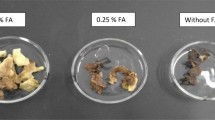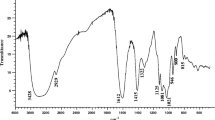Abstract
The marine waters of the Baja California peninsula (Mexico) are a rich source of brown seaweeds with a great potential for exploitation. For that reason, Sargassum sinicola, Eisenia arborea, and Macrocystis pyrifera collected from different locations were subjected to extraction of sodium alginate using a pilot-plant scale process developed in our facilities. The composition and sequence parameters of the recovered alginate were studied by infrared and nuclear magnetic resonance spectroscopy. The spectral analysis of the products revealed that sodium alginate from S. sinicola contains a greater proportion of guluronate monomers (64%) than that from E. arborea (48%), and M. pyrifera (38%). Computation of the frequencies of diads and triads indicated that the alginate from S. sinicola was constructed by intercalated guluronate-blocks of 14 residues in length. In contrast, the length of the G-block in the alginates from E. arborea and M. pyrifera were 7 and 4 residues, respectively. The results show that S. sinicola, E. arborea, and M. pyrifera are sources of sodium alginate with different mannuronate/guluronate ratios, as well as a varied building-block length. In consequence, aqueous dispersions of sodium alginate from the three studied species are expected to exhibit different physical properties.
Similar content being viewed by others
Avoid common mistakes on your manuscript.
Introduction
Alginates are a family of linear polysaccharides occurring as a structural component of the cell wall in marine brown algae and bacteria. The monomers in alginate, β-d-mannuronic acid (M) and its C-5 epimer α-l-guluronic acid (G), can be arranged in varying proportions and sequence in a chain bound by 1→4 linkages (Haug 1964, p. 6). The M and G residues are organized in blocks of consecutive M (M blocks), consecutive G (G blocks), or alternating M and G residues (MG blocks). The gelling characteristics of alginates are greatly influenced by the monomer composition and sequence (Gacesa et al. 1983). The composition of the alginates is a very important issue, because of the extensive range of industrial applications of alginates, which in turn are related to their physical properties.
The seaweeds belonging to the order Laminariales [Macrocystis pyrifera (Linnaeus) (Agardh 1820); Eisenia arborea (Areschoug 1876)] and Fucales [Sargassum sinicola (Setchell and Gardner 1924)] are the most abundant in the seas of the Baja California peninsula, Mexico, making them highly suitable for industrial exploitation as a source of alginates (Pacheco-Ruíz et al. 1998; Hernández-Carmona 2000, p. 3). Of those three brown seaweeds species, the giant kelp M. pyrifera has been harvested in Baja California since the 1950s. In 1989, more than 44,000 tons of fresh M. pyrifera were sent for alginate extraction to the CP Kelco plant (San Diego, CA). That amount was estimated to account for only one-half of the total estimated harvestable biomass of M. pyrifera (Hernández-Carmona 2000, p. 3). A total biomass of around 150,000 tons of S. sinicola was estimated from beds in the coast of the Gulf of California (Pacheco-Ruíz et al. 1998). Along the west side of Baja California, adjacent to and in the M. pyrifera beds, E. arborea grows abundantly (unpublished field observation), but the harvestable stock of this seaweed has not yet been determined. The algal resources mentioned might account for more than 200,000 tons of fresh algae harvestable annually. With this in mind, our research center has for many years invested considerable effort dedicated to the optimization of techniques for extraction of alginates. The monomer composition and sequence in alginates from M. pyrifera has been previously reported (Stokke et al. 1991; Smidsrød and Draget 1996). However, no information was found in the literature concerning the composition of alginates from E. arborea, and S. sinicola. In this manuscript, we report the detailed composition and sequence parameters of uronic acids in the alginates from M. pyrifera, E. arborea, and S. sinicola following the extraction procedures optimized by our research group. In this way, we hope to evaluate potential uses for alginates when a specific composition is required, as this is known to vary widely from species to species.
Materials and methods
Algae
For this study, algae were collected from different localities of the Baja California peninsula (Mexico) between summer 2002 and autumn 2003 by scuba diving. The gathered seaweeds were sun dried, and milled. The sodium alginate extraction of 10 kg dry M. pyrifera was conducted at pilot plant scale as described in previous papers (Hernández-Carmona et al. 1998, 1999, 2002; McHugh et al. 2001). Alginates from S. sinicola (20 kg) and E. arborea (10 kg) were extracted using the same method, but the process was optimized for each one. The alginates studied here are referred to as: Alg-Mp (sodium alginate from M. pyrifera), Alg-Ss (sodium alginate from S. sinicola) and Alg-Ea (sodium alginate from E. arborea).
Spectroscopy
Infrared (Fourier transformed infra-red spectroscopy; FTIR) spectra were acquired in transmission mode from thin films. The films were prepared by drying 2 mL of a 1% aqueous solution (w/v) of sodium alginate at 50°C in polystyrene molds. The FTIR spectra were recorded with a Perkin Elmer Paragon 500 FTIR spectrometer. All spectra were acquired in the spectral range of 4,000–400 cm−1 at a resolution of 4 cm−1.
The sequence parameters of alginates were determined by 1H-nuclear magnetic resonance (1H-NMR) spectroscopy at the Norwegian Biopolymer Laboratory of the Norwegian University of Science and Technology. Spectra were recorded at 300.13 MHz with a Jeol FX-300 FT-NMR spectrometer, a sweep width of 3,591.9 Hz, and an acquisition time of 4.561 s. The data were processed with a line broadening of 0.3 Hz. 3-(Trimethylsilyl)-propanesulfonate was used as an internal standard. The frequencies of monads (G, M), diads (GG, GM, MM) and triads (GGG, GGM, MGM) were determined by integration of peaks at δ5.05, 4.75, 4.72, 4.70, 4.67, and 4.45 ppm (Grasdalen et al. 1979; Davis et al. 2003).
Results and discussion
The FTIR spectra showed absorption bands or shoulders that were readily assigned to sodium alginate at 3390, 2930, 1615, 1410, 1320, 1300, 1170, 1150, 1125, 1090, 1035, 950, 900, 890, 815 and 780 cm−1. A detailed comparison of the fingerprint region of the FTIR spectra revealed differences in the relative intensity of several bands, shown in Table 1 as the absorbance ratio relative to the carboxylate band at 1615 cm−1. In particular, the greater relative intensity of bands at 1125 and 1090 cm−1 for Alg-Ss, together with absorption at 1320 and 1000 cm−1 and a lack of absorption at 1300, 1170, 1050 and 890 cm−1, was a clear indication that Alg-Ss is composed of a higher proportion of guluronate monomers than the other alginates examined here. In contrast, Alg-Mp showed a typical set of bands of a high mannuronate alginate at 1300, 1250, 1170, 1050, 890, and 820 cm−1. The FTIR trace of Alg-Ea was clearly a combination of that of Alg-Ss and Alg-Mp, suggesting that Alg-Ea is composed of similar amounts of both M and G monomers. In a semi-quantitative approach, FTIR spectroscopy revealed the content of guluronic residues in the analyzed alginates to be Alg-Mp < Alg-Ea < Alg-Ss. These findings were confirmed by computation of the frequencies of monads, diads, and triads (Table 2). The M/G molar ratio of the alginates was determined to be 0.56, 1.08, and 1.63 for Alg-Ss, Alg-Ea, and Alg-Mp, respectively. Of these three samples, Alg-Ss was highest in guluronic monomer content (64%), followed by Alg-Ea (48%), then Alg-Mp (38%). The homopolymeric G-blocks were 14, 7 and 4 G-residues in length for Alg-Ss, Alg-Ea, and Alg-Mp, respectively. All FTIR and 1H-NMR data were consistent with previously published works (Mackie 1971; Grasdalen et al. 1979; Sartori et al. 1997; Davis et al. 2003).
The determination of the monomer composition and sequence of Alg-Ss, Alg-Ea, and Alg-Mp revealed great differences between them. Such variations are important, because they determine the physical properties of these alginates. In general, alginates having a low M/G ratio (such as Alg-Ss) would give strong, brittle gels, making them suitable for cell encapsulation for biomedical or environmental applications, whereas alginates having a high M/G ratio (such as Alg-Ea and Alg-Mp) would form more elastic gels, which may be desirable for food, cosmetic or pharmaceutical products.
Abbreviations
- Alg-Ea:
-
Sodium alginate from Eisenia arborea
- Alg-Mp:
-
Sodium alginate from Macrocystis pyrifera
- Alg-Ss:
-
Sodium alginate from Sargassum sinicola
- FTIR:
-
Fourier transformed infra-red spectroscopy
- G:
-
α-l-guluronic acid
- M:
-
β-d-mannuronic acid
- NG>1 :
-
Average G-block length
- 1H-NMR:
-
Nuclear magnetic resonance spectroscopyof protons
References
Agardh CA (1820) Species algarum rite cognitae, cum synonymis, differentiis specificis et descriptionibus succinctis. Vol. 1, Part 1. Lund, Berling, p 168
Areschoug JE (1876) De tribus Laminarieis (Egregia Aresch., Eisenia Aresch., Nereocystis) et de Stephanocystide osmundacea (Turn.). Trevis. observationes praecursorias offert. Botaniska Notiser, p 65–73
Davis TA, Llanes F, Bohumil V, Diaz-Pulido G, McCook L, Mucci A (2003) 1H-NMR study of Na alginates extracted from Sargassum spp. In relation to metal biosorption. Appl Biochem Biotechnol 110:75–90
Gacesa P, Squire A, Winterburn PJ (1983) The determination of the uronic acid composition of alginates by anion-exchange liquid chromatography. Carbohydr Res 118:1–8
Grasdalen H, Larsen B, Smidsrød O (1979) A p.m.r. study of the composition and sequence of uronate residues in alginates. Carbohydr Res 68:23–31
Haug A (1964) Composition and properties of alginates. In Report No. 30. Norwegian Institute of Seaweed Research. Trondheim, Norway
Hernández-Carmona G, McHugh DJ, Arvizu-Higuera DL, Rodríguez-Montesinos YE (1998) Pilot plant scale extraction of alginate from Macrocystis pyrifera. 1. Effect of pre-extraction treatments on yield and quality of alginate. J Appl Phycol 10:507–513
Hernández-Carmona G, McHugh DJ, López-Gutiérrez F (1999) Pilot plant scale extraction of alginate from Macrocystis pyrifera. 2. Studies on extraction conditions and methods of separating the alkaline-insoluble residue. J Appl Phycol 11:493–502
Hernández-Carmona G (2000) El alga gigante Macrocystis pyrifera (L.) C. Agardh en Baja California Sur, México: Ecología y su aprovechamiento para la producción de alginatos. PhD Thesis. Centro de Investigaciones Biológicas del Noroeste, La Paz, México, p 3
Hernández-Carmona G, McHugh DJ, Arvizu-Higuera DL, Rodríguez-Montesinos YE (2002) Pilot plant scale extraction of alginates from Macrocystis pyrifera. 4. Conversion of alginic acid to sodium alginate, drying and milling. J Appl Phycol 14:445–451
Mackie W (1971) Semi-quantitative estimation of the composition of alginates by infra-red spectroscopy. Carbohydr Res 20:413–415
McHugh DJ, Hernández-Carmona G, Arvizu-Higuera DL, Rodríguez-Montesinos YE (2001) Pilot plant scale extraction of alginates from Macrocystis pyrifera. 3. Precipitation, bleaching and conversion of calcium alginate to alginic acid. J Appl Phycol 13:471–479
Pacheco-Ruíz I, Zertuche-González JA, Chee-Barragán A, Blanco-Betancourt R (1998) Distribution and quantification of Sargassum beds along the west coast of the Gulf of California, Mexico. Bot Mar 41:203–208
Sartori C, Finch DS, Ralph B, Gilding K (1997) Determination of the cation content of alginate thin films by Ft i.r. spectroscopy. Polymer 38:43–51
Setchell WA, Gardner NL (1924) New marine algae from the Gulf of California. Proceeding of the California Academy of Science, Series 4, Vol. 12, p 695
Smidsrød O, Draget KI (1996) Chemistry and physical properties of alginates. Carbohydr Europe 14:6–13
Stokke BT, Smidsrød O, Bruheim P, Skjåk-Bræk G (1991) Distribution of uronate residues in alginate chains in relation to alginate gelling properties. Macromolecules 24:4637-4645
Acknowledgments
This work was supported by grants from SIP, COFAA and EDI (Instituto Politécnico Nacional, México). The authors thank Liz Rodríguez, Dora Arvizu, Ricardo Yabur, Mau Muñoz and Jorge Castro for assistance during the collection of the algal material and the extraction procedure. Dr. Rosalba Encarnación-Dimayuga is acknowledged for allowing us to use the FTIR spectrometer.
Author information
Authors and Affiliations
Corresponding author
Rights and permissions
About this article
Cite this article
Murillo-Álvarez, J.I., Hernández-Carmona, G. Monomer composition and sequence of sodium alginate extracted at pilot plant scale from three commercially important seaweeds from Mexico. J Appl Phycol 19, 545–548 (2007). https://doi.org/10.1007/s10811-007-9168-5
Received:
Accepted:
Published:
Issue Date:
DOI: https://doi.org/10.1007/s10811-007-9168-5




